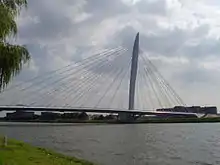Amsterdam–Rhine Canal
| Amsterdam–Rhine Canal | |
|---|---|
 Map of the Amsterdam–Rhine Canal | |
| Specifications | |
| Length | 72 km (45 mi) |
| History | |
| Date completed | 1952 |
| Geography | |
| Start point | Amsterdam, Netherlands |
| End point | Waal river near Tiel, Netherlands |
The Amsterdam–Rhine Canal (Dutch: Amsterdam-Rijnkanaal) is a canal in the Netherlands that was built to connect the port and capital city of Amsterdam to the main shipping artery of the Rhine. Its course follows a generally southeasterly direction as it goes through the city of Utrecht towards Wijk bij Duurstede where it intersects the Lek branch of the Rhine and then continues on to the river Waal near Tiel, with a branch, the Lek Canal, to the Lek near Nieuwegein.[1][2] The Amsterdam-Rhine Canal is the world's most frequented artificial waterway with an annual average of 100,000 ships.[3]
Bridges
Wikimedia Commons has media related to Amsterdam-Rhine Canal.
Rail bridges (with nearest train station on the west and east bank):
- between Diemen/Diemen-Zuid and Weesp
- Demkaspoorbrug, between Maarssen and Utrecht Centraal
- Vleutensespoorbrug, between Utrecht Leidsche Rijn and Utrecht Centraal
- between Culemborg and Houten
- between Tiel and Kesteren
 Utrecht, the Demkaspoorbrug across the canal
Utrecht, the Demkaspoorbrug across the canal Utrecht, the Meernbrug across the canal
Utrecht, the Meernbrug across the canal Utrecht, the Prins Clausbrug across the canal
Utrecht, the Prins Clausbrug across the canal The canal near Rijswijk, Gelderland
The canal near Rijswijk, Gelderland The canal near Tiel
The canal near Tiel
References
- "Amsterdam-Rhine Canal". Encyclopedia Britannica. Retrieved 2022-08-30.
- "Amsterdam-Rijnkanaal". Rijkswaterstaat (in Dutch). Retrieved 2022-08-30.
- "Amsterdam-Rhine canal most busiest canal in the world". Rijkswaterstaat on Twitter (in Dutch). Retrieved 2023-02-08.
This article is issued from Wikipedia. The text is licensed under Creative Commons - Attribution - Sharealike. Additional terms may apply for the media files.